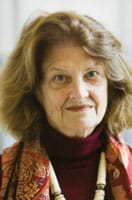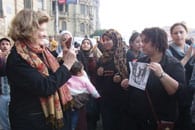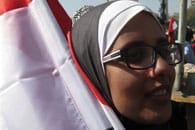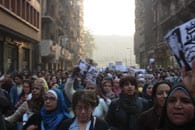Women Marching for Revolution in Egypt
Women Marching for Revolution in Egypt: A Participatory Narrative
By Dr. Margot Farranto Badran ’58

Dr. Margot Farranto Badran ’58
Historian Margot Farranto Badran ’58 was in Egypt at the start of the Revolution of 2011, later called the Arab Spring, where she was taking part in events and interviewing revolutionaries. As a young scholar in the making, not long out of Trinity in the 1960s, she interviewed women who had experienced the 1919 revolution in Egypt and pioneered a feminist movement in its aftermath. She authored Feminists, Islam, and Nation: Gender and the Making of Modern Egypt, a book on women in the national revolution and inaugural feminist movement; Feminism in Islam: Secular and Religious Convergences; and translated, edited, and introduced Harem Years: The Memoirs of an Egyptian Feminist, Huda Shaarawi (1879-1924). She is a senior scholar at the Woodrow Wilson International Center for Scholars and a senior fellow at the Prince Alwaleed Bin Talal Center for Muslim-Christian Understanding at Georgetown University. She is now writing a book on the resurgent feminist movement that is part of the ongoing revolution in Egypt today. Here she shares with us a few pages from the journal she is keeping on the revolution.
March 8, 2011: International Women’s Day March
 On International Women’s Day, revolutionary women, along with supportive men, went out on the first women’s demonstration since the deposing of President Hosni Mubarak on February 11. As I joined those who had begun to gather around midday among the tents and grassy spaces in the circular island in the heart of Tahrir Square, I recalled learning about the very first demonstration Egyptian women held on March 16 at the start of the 1919 revolution in protest against British colonial rule. I remembered Gamila Atiya, when she was an old woman back in the 1960s, who told me how she had distributed revolutionary leaflets at the Saniyya School. Now in 2011, I am in the midst of protesters busy distributing placards in exhilarant anticipation of the start-up of the demonstration confirming women’s revolutionary commitment, and protesting women’s exclusion from the constitutional committee appointed at the behest of the Supreme Council of the Armed Forces (SCAF) to propose amendments to the Constitution prior to parliamentary elections. Although sundry workers and professional groups had publically agitated for their rights since the fall of Mubarak, women were the first group in Egypt to take SCAF head-on.
On International Women’s Day, revolutionary women, along with supportive men, went out on the first women’s demonstration since the deposing of President Hosni Mubarak on February 11. As I joined those who had begun to gather around midday among the tents and grassy spaces in the circular island in the heart of Tahrir Square, I recalled learning about the very first demonstration Egyptian women held on March 16 at the start of the 1919 revolution in protest against British colonial rule. I remembered Gamila Atiya, when she was an old woman back in the 1960s, who told me how she had distributed revolutionary leaflets at the Saniyya School. Now in 2011, I am in the midst of protesters busy distributing placards in exhilarant anticipation of the start-up of the demonstration confirming women’s revolutionary commitment, and protesting women’s exclusion from the constitutional committee appointed at the behest of the Supreme Council of the Armed Forces (SCAF) to propose amendments to the Constitution prior to parliamentary elections. Although sundry workers and professional groups had publically agitated for their rights since the fall of Mubarak, women were the first group in Egypt to take SCAF head-on.
While in Tahrir Square I noticed a dark look come across the face of one of the young men who had just heard ominous threats coming from what appeared to be thugs. I thought it was just swagger and paid no attention. I left the square early as I had to pack and fly out to Istanbul the following day en route back to Washington. I learned from the in-flight news that the women’s demonstration had turned nasty and that women had been verbally and physically assaulted. It was the first clear public sign since the euphoria of the first 18 days of the uprising, which ended with the ouster of Mubarak and early aftermath, that all was not well and that the new revolution was being attacked through women by thugs and their paymasters presumed to be felool, or remnants of the old regime. The following day, young women protesters were sexually assaulted by men in military uniform showing a more complex and troubling picture.
Summer and Fall 2011: Women at the Forefront
 Throughout the summer and fall of 2011, women were defending the revolutionary ideals of dignity, freedom and social justice, making sure that all segments of society were included in the making of the new democratic order. Women remained in the forefront of fighting the counter-revolutionaries, tyrannical authoritarianism and patriarchal atavism in whatever clothes and guise. In December, following the recent parliamentary elections, repression of demonstrators from all walks of life turned violent as the world witnessed the attacks by plainclothes and uniformed men in Mustafa Mahmud Street just off Tahrir Square and in front of the Parliament building. Women, as usual, were in the front line. The assault, stripping and knocking to the ground of a woman protester in front of the Parliament surrounded by uniformed men was captured in a picture showing one of the soldiers kicking her stomach. The image of “the woman in the blue bra” went viral bringing thousands of women out into a demonstration on December 20.
Throughout the summer and fall of 2011, women were defending the revolutionary ideals of dignity, freedom and social justice, making sure that all segments of society were included in the making of the new democratic order. Women remained in the forefront of fighting the counter-revolutionaries, tyrannical authoritarianism and patriarchal atavism in whatever clothes and guise. In December, following the recent parliamentary elections, repression of demonstrators from all walks of life turned violent as the world witnessed the attacks by plainclothes and uniformed men in Mustafa Mahmud Street just off Tahrir Square and in front of the Parliament building. Women, as usual, were in the front line. The assault, stripping and knocking to the ground of a woman protester in front of the Parliament surrounded by uniformed men was captured in a picture showing one of the soldiers kicking her stomach. The image of “the woman in the blue bra” went viral bringing thousands of women out into a demonstration on December 20.
December 20, 2011: The women’s march in protest against violence perpetrated by the military against women and other revolutionaries
 On this Tuesday afternoon as the conference on Islam, Citizenship and the New Media in pre- and post-revolutionary Egypt, organized by the Netherlands-Flemish Institute in Cairo, was winding down, news came through cell phones that a women’s march was assembling in Tahrir Square. A young revolutionary and veteran of “the battle of Muhammad Mahmud Street,” Nihal Saad, jumped into her car and drove us across the Nile to Tahrir. As we walked toward the Mogamma Building where the marchers were assembling I saw a huge banner with the name of the Coptic martyr Mina Daniel from the recent Maspero demonstrations. Later we would see banners with crescents and crosses entwined (reminiscent of the iconography of the 1919 revolution). We circled once around the Tahrir median and then headed toward Talaat Harb Street and the center of town. I was in the teeming stream when I felt a flicker of fear. It was like being on a train and unable to get off. It lasted just a brief moment, for soon I felt a part of a powerful defiant mass united in a common cause. The march was in protest against the continued physical and sexual abuse of women by the military and police as a weapon of intimidation. Every single woman felt the violation of women very viscerally, and many men did too. A common revulsion against the rule of the SCAF was the ultimate uniting factor.
On this Tuesday afternoon as the conference on Islam, Citizenship and the New Media in pre- and post-revolutionary Egypt, organized by the Netherlands-Flemish Institute in Cairo, was winding down, news came through cell phones that a women’s march was assembling in Tahrir Square. A young revolutionary and veteran of “the battle of Muhammad Mahmud Street,” Nihal Saad, jumped into her car and drove us across the Nile to Tahrir. As we walked toward the Mogamma Building where the marchers were assembling I saw a huge banner with the name of the Coptic martyr Mina Daniel from the recent Maspero demonstrations. Later we would see banners with crescents and crosses entwined (reminiscent of the iconography of the 1919 revolution). We circled once around the Tahrir median and then headed toward Talaat Harb Street and the center of town. I was in the teeming stream when I felt a flicker of fear. It was like being on a train and unable to get off. It lasted just a brief moment, for soon I felt a part of a powerful defiant mass united in a common cause. The march was in protest against the continued physical and sexual abuse of women by the military and police as a weapon of intimidation. Every single woman felt the violation of women very viscerally, and many men did too. A common revulsion against the rule of the SCAF was the ultimate uniting factor.
The women marchers were mainly, it seemed, in their 20s and 30s, but there were many middle-aged women and some older women. I met one middle-aged woman who told me her four daughters were marching. There were a few mothers with infants. Most of the women seemed to be of ordinary circumstances while there were also women of more privileged backgrounds. On either side of the women – we could have been between 15 and 20 abreast – were lines of men single-file and often holding hands acting as protective cordons. This reminded me of the pictures I had seen of male students who formed lines on either side of the women protestors in 1919. The men were mainly of ordinary background. Near me was a man in a hard hat, a peasant with a scarf wrapped around his head like a turban, a man with bandages on head wounds, and a wizened old man.
Women protestors held up the front pages of newspapers with the picture of the woman in the blue bra and posters saying “women are the red line.” Toward the beginning of the march I heard someone call my name. It was Dina Abouelsoud, founder of the Revolutionary Women’s Coalition which began forming during the initial uprisings, whom I had met during the preparations for the first women’s march on March 8. I quickly snapped a picture of her holding up the image of the woman in the blue bra before she suddenly disappeared into the crowd. As we went along, men in the lines on the side shouted in rhyme: “Wahed itain! Ragula rah fain?” – “One, two! Where’d your manhood go?”
As we made our way down Talaat Harb Street crowds appeared high above on the balconies of apartments and offices, looking down and cheering us on. Some of the women shouted up to them: Come down and join us, look what they are doing to your daughters! When we looped toward Ramsis Street we found people lined up shoulder-to-shoulder on the overpass. The sun was going down as we headed toward the Cairo Journalists’ Syndicate where we stopped briefly to greet the throngs on the steps. We then continued on toward the center of town. By this time it was dark but the hundreds of tiny lights from flashing cell phones and cameras lit up the night giving it a festive air.
December 23, 2011: Women marching in unison with other groups from Al-Azhar mosque to Tahrir Square
The following Friday – the Sabbath and a common day for protests – I participated in another women’s demonstration protesting orchestrated violence against women and other revolutionaries as it gathered in front of Al-Azhar Mosque where it was to join forces with other groups. After Friday prayer we headed in a huge phalanx toward Tahrir Square marching up on the flyovers high above the city. People were protesting the shooting at close range days before near the Parliament of the Shaikh Imad Effat; he was an immensely popular revolutionary, from an Islamic institute that issues fatwas or religious rulings. I carried two posters back-to-back: one with white letters against a red background saying women are the red line and the other with a picture of Shaikh Imad.
I got separated from two women friends on the flyover but there was nothing to do but to keep marching ahead. A scary moment occurred when something that sounded like gun shots went off and I saw birds flying up in the sky. I did not notice anyone paying attention and just kept going forward. A man noticing my apprehension said, in an Arabic phrase that took a minute to decipher, that the explosions were firecrackers. It was an amazing sight as we walked high above the city looking down over the railings on tiny figures below going about their everyday business. After about four hours we made it to Tahrir. I headed to a place near Tahrir for some falafel. Minutes later, to my utter surprise and delight, the two young women I had lost on the flyover popped in as well. We saluted the revolution.